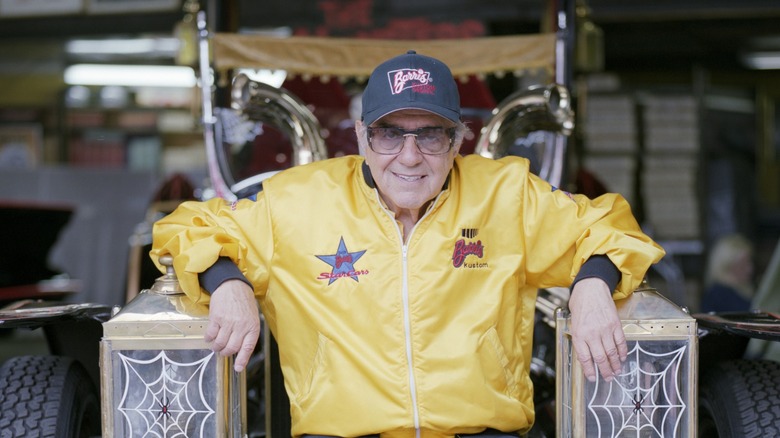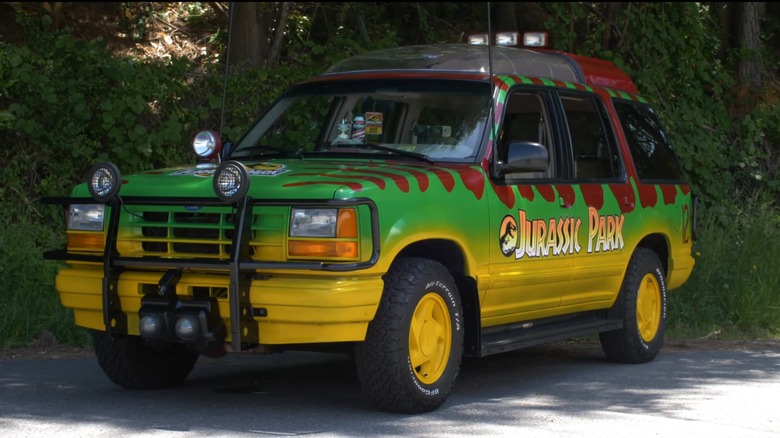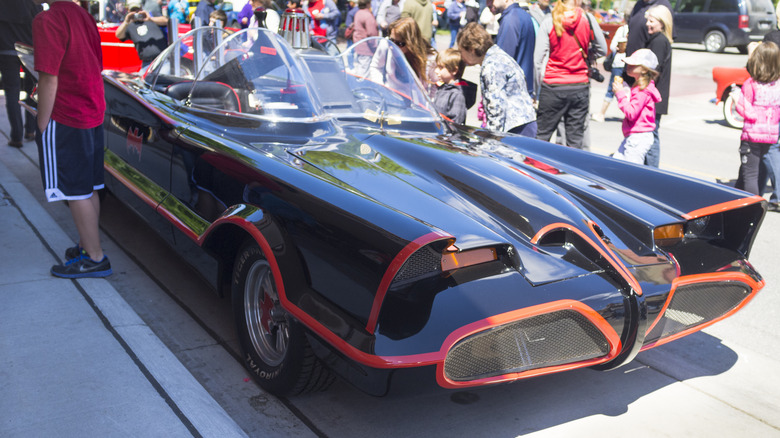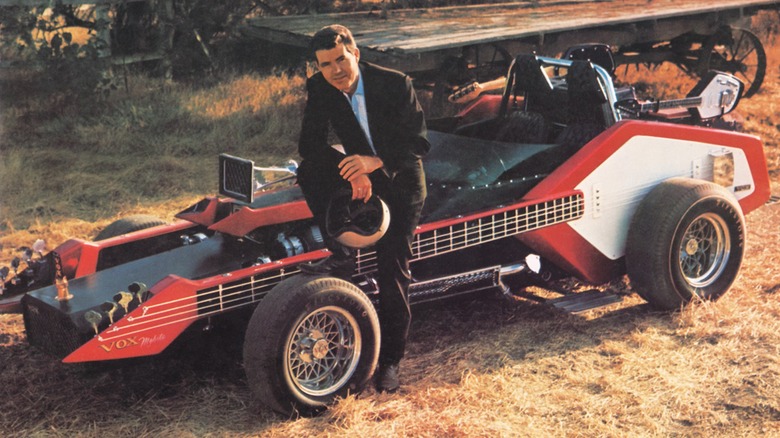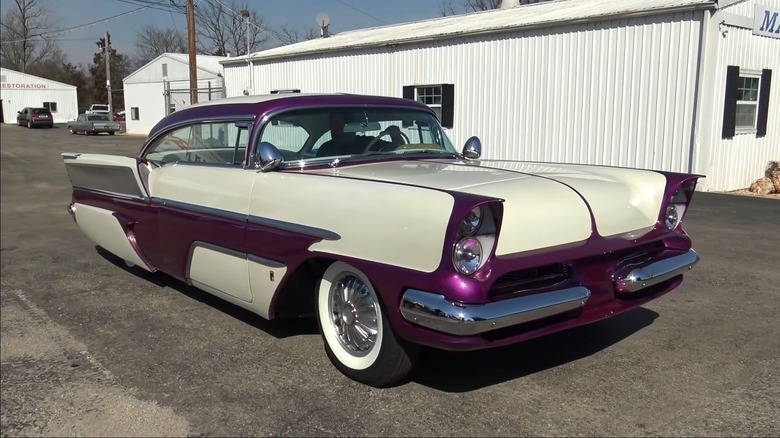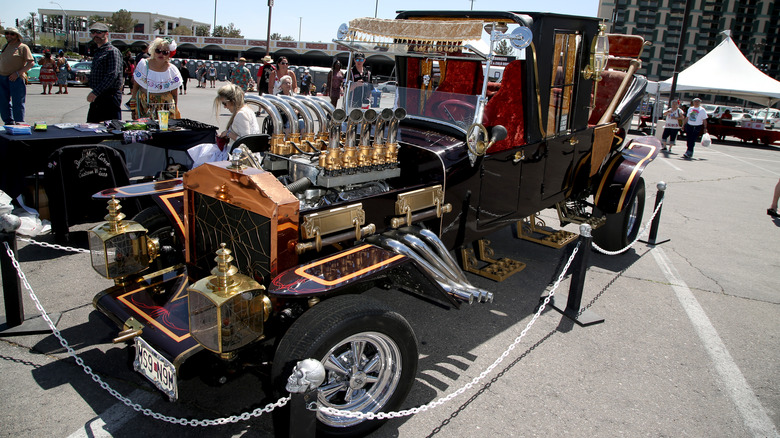10 Of The Coolest Custom Cars Ever Built By George Barris
Cars have been status symbols ever since they were invented. Initially, only the rich could afford cars, but as manufacturing techniques and technologies became cheaper and more widespread, so did cars. But even though cars are now the de facto form of transportation, you can often tell how rich someone is just by looking at their car. A clunker sometimes means the driver probably can't afford much else, while a Lamborghini often implies they've got cash to spare. And then there are custom cars.
Most cars roll off assembly lines and are built by both technicians and automated robots, which does wonders for affordability. Even prohibitively expensive luxury cars are built on factory floors, but custom cars are constructed one at a time. Usually, a crack engineer or team of automotive experts takes an existing car and alters it. The show "Pimp My Ride" was a popular source of custom vehicles, but people who wanted true masterpieces on wheels went to the likes of George Barris. Who was George Barris, you ask? Essentially, he was to car customization what Andy Serkis is to motion capture. Barris and his company, Barris Kustom Industries, crafted numerous iconic cars for TV and the movies from the 1960s to the 1980s, but he also customized plenty of vehicles for personal collections.
George Barris passed away in 2015. Here are some of the coolest cars to ever host his genius.
Jurassic Park tour vehicles
In Hollywood movies, technical experts are usually listed in the credits. This lets audiences know who worked on what and acts as both resume and demo reel. Sometimes crew members and actors refrain from taking credit if they are embarrassed by their work or the final product, but why would anyone not take credit for creating one of the most famous custom cars in movie history?
The Tour Vehicles from Jurassic Park are the quintessential safari vehicle. Each car sports a yellow-green gradient paint job topped with blackish-brown stripes that evokes early concepts of dinosaurs, before paleontologists learned many were covered in feathers. And we can't forget the Tour Vehicle's multitude of lights, designed to help spot dinosaurs during the fictional Isla Nublar's tropical storms. These cars scream "we're going dinosaur sightseeing" and are just so elegant in their simplicity and realism. It makes the iconic T-rex attack that demolishes the cars all that more visceral.
In the original "Jurassic Park" novel, the Tour Vehicles were Toyota Land Cruisers, but for the film, 1992 Ford Explorers were used. While George Barris is uncredited in the film, it is widely recognized that he transformed the Ford Explorers into the cars film buffs the world over love. Not only did Barris provide the iconic paint job and install the extra lights and glass roof, he also helped propagate the illusion that the cars were autonomous. Barris allegedly set up a system that let literal backseat drivers control the Tour Vehicles while remaining out of view from the cameras. Not only was George Barris a talented automotive customizer, he was also wise in the ways of movie magic.
The Batmobile
In 1965, the TV studio Greenway Productions asked the automobile customizer Dean Jeffries to start reshaping a 1959 Cadillac for a then-upcoming show. He started work, but when Greenway Productions asked that it be completed faster than expected, Jeffries passed it on to George Barris. While Jeffries eventually went on to build the iconic Black Beauty from "The Green Hornet," Barris' creation turned into one of the most recognizable superhero vehicles of all time.
The 1966 "Batman" show is one of the best superhero series of all time (the absolute best being 1992's "Batman: The Animated Series," no contest). While Batman was always a beloved comic book hero, the 1966 live action series increased that popularity tenfold thanks to its camp and casting. The show's iconic Batmobile also helped. The vehicle looks silly and is bursting at the seams with every bat-gadget, bat-gizmo, and bat-gewgaw the caped crusader would ever need. The Batmobile is as much a character as the main cast, and we have George Barris to thank for it.
The 1966 Batmobile began life as a 1955 Ford Lincoln Futura. While the Futura didn't initially leave the impact its designers hoped for, Barris and crew transmogrified and immortalized the car in as little as three weeks. Almost every inch of the car was altered, from the front grill to the rear fins. Oh, and a five-gallon paint can was added to create the Batmobile's exhaust. Technically, Barris created four Batmobiles: One for racing, one for stunts, one for crashing, and one for effects. While the Futura cost $250,000 to make, George Barris bought it for a buck and later sold it at auction for $4,200,000. Crime might not pay, but customizing cars for fictional crime fighters sure does.
The Emperor
Roadsters are defined as luxury two-seater cars without roofs. Unlike convertibles and their fold-away roofs, if you get caught in the rain while driving a roadster, you're gonna get wet. Many car manufacturers sell roadsters, but plenty of customizers design their own roadster hot rods — hot rods are by definition custom jobs. And since hot rods are some of the coolest vehicles on the road, of course George Barris' roadster hot rod would leave the rest in the dust.
The Emperor is a fitting name for Barris' coolest roadster. The car has a sleek, simple body with an exposed engine, large custom grill, and luxurious air foam upholstery. Like any true roadster, The Emperor is built for power and speed, and when the engine starts up, you can hear its symphony of horsepower. Of course, we are far from the only people to praise Barris' hot rod: According to mecum.com, the Emperor was featured on the July 1960 cover of Hot Rod Magazine and won the award for "1960 America's Most Beautiful Roadster."
While The Emperor is primarily associated with Barris and his crew, Chuck Krikorian worked on the car first. He began by combining a 1929 Ford Model A roadster body with 1931 Ford Model A frame rails and a modified 1957 Cadillac 365 CI V-8 engine. Krikorian wanted to create a drag racer, but his brother-in-law and best friend convinced him to change gears and create a show car, after which Krikorian handed the project over to Barris Kustom Industries. Barris finished the job and painted the car with 40 coats of translucent Kandy Burgundy, pure Swedish pearl of essence, and crushed diamond dust. Depending on the lighting, The Emperor can look either red and white or magenta and pearl.
Voxmobile
Every car is essentially a billboard in motion. Different car models advertise the engines, safety features, and aesthetics of their respective manufacturers; well-kept used cars show you can purchase quality vehicles at less than market cost; and custom cars tell the world what an imaginative engineer and a boatload of cash can create. In certain cases, custom cars can serve as literal billboards for products such as electric guitars and amps.
The Voxmobile is a simple name for a not-so simple car. In 1967, George Barris built the vehicle at the request of Vox — the guitar manufacturer, not the news outlet. This roadster was designed to look like a Vox guitar when viewed in silhouette. Barris achieved this goal by fabricating giant fake Vox guitars, specifically Vox Phantoms, and attaching them to the roadster's sides. Looks silly, but wait until you hear what it sounds like.
Vox didn't want the Voxmobile to serve as just a car-shaped advertisement for the company's products; Vox wanted it to be a fully functioning Vox product, too. To this end, Barris installed numerous speakers, including three Vox Beatle amps, and a grand total of 32 audio jacks along the faux Phantom sides. Barris also installed a small performance stage at the rear of the Voxmobile that could accommodate up to three guitarists and one organist. Since Vox amplifiers are some of the best on the market, anyone who witnessed the Voxmobile in its prime could have seen it drive down a parade route while musicians belted out some serious rock 'n' roll.
Moonscope
NOTE: Above you'll see a video running down Barris' custom vehicles. At around the 1:17 mark, you'll catch a peek at the original Moonscope custom concept car.
Many car customizers know their way around a vehicle. But not many are so confident in their grasp of mechanics that they would try to design a working vehicle intended for use on the Moon. But George Barris believed.
Barris' Moonscope – not to be confused with a model toy car of the same name that Barris also designed — is a concept car intended for lunar transportation. We don't mean Barris created something vaguely space-themed; he did his research and crafted a rover that hypothetically could function on the Moon if ever given the chance. And yes, this Moonscope was also adapted into its own plastic model kit.
The Moonscope rover broke from customizer tradition and didn't use any car parts. Instead, some components were supplied by manufacturers, and others were built by hand. For instance, since the Moon doesn't have any oxygen to facilitate standard gas combustion, Barris opted for an electric platform by General Electric. To properly navigate the moon's dusty, crater-pocked surface, Barris and his team crafted a six-wheel design, complete with specialized shocks. The Moonscope even went beyond pure mobility, as it also included a storage compartment for extra oxygen bottles, so astronauts wouldn't run out during extended trips. While the Moonscope never made it to the lunar surface, NASA allegedly contacted George Barris to use his designs for the Mars mission. If true, the spirit of Barris and the Moonscope might very well live on in the Mars Rover and all future Mars probes.
Kargoyle
George Barris had a love-hate relationship with hearses. When he started working on the Munster's Koach for the show "The Munsters," (more on that later), he was against using a hearse for their vehicle. However, when Barris eventually customized a hearse for either the 1980 film "Terror on Wheels" or "Gargoyles" — sources differ on which — he birthed a car worthy of a Meat Loaf album cover.
The Kargoyle not only sports an awesomely punny name but is a sight to behold. Just like the gargoyles that serve as its namesake, this vehicle is an unholy fusion of several vehicles, specifically a hearse and a hot rod. The car sports the elongated shape of most hearses, but its engine block is much larger, almost cartoonishly so, and that's to say nothing of the giant air scoop in the middle of the engine. Combined with a deliciously dark purple paint job and gargoyles on the side, the Kargoyle could easily be confused for a car designed by Ed Roth in the best way possible.
To create the Kargoyle, George Barris started with a 1967 Cadillac Funeral Coach Miller-Meteor and added a 427-CID V8 engine. The Barris team also added lake pipes (exhaust pipes under the doors that blow outward) and suicide doors (doors that hinge to the back of the car instead of its front).
To make the car truly ghoulish, Barris and crew installed custom spider-web wheel hubcaps and steering wheel, topped the car off with a custom metal flask paint, and airbrushed the aforementioned gargoyles. While the Kargoyle was initially crafted for a movie, it also served as the personal Halloween conveyance of Playboy girls in "The Girls Next Door," as well as the PR hearse for Mӧtley Crüe's final tour.
X.P.A.C. 400 Air Car
The Greek philosophers Plato and Diogenes once had an argument over how to describe "man." When Plato defined man as a "featherless biped," Diogenes presented him with a plucked chicken. While Diogenes was technically correct, as the chicken was indeed a biped without feathers, it was certainly not a man. Moral of the story: Nailing down definitions can be tricky. Just look at George Barris' air car, which doesn't have wheels.
The X.P.A.C. 400 Air Car (or XPAK 400) was a "car" that ran on a cushion of air. This would make it more of a hovercraft than anything else. The vehicle didn't have any transmission, and was powered by two aircraft starter motors tied to twenty-inch aluminum fans. Built for a 1960 New York auto show, the car was designed to look as futuristic as possible, complete with flying-saucer shape and huge side fins. The X.P.A.C. 400 looked like something you would find at a "Jetsons"-themed bumper car ride.
NOTE: Above you'll see an episode (S1E12) of "The Alfred Hitchcock Hour" called "Hangover." This episode uses the X.P.A.C. 400 Air Car as a prop starting at around the 21:39 mark.
Like the Moonscope, to say George Barris customized the X.P.A.C. 400 would be a misnomer because that would imply he used an existing car as the skeleton. The main body was handmade and formed out of aluminum and plexiglass. As for the paint job, Barris allegedly used a mix of diamond dust and fish scales to achieve a pearlescent finish. While the final product didn't have enough lift to ferry an actual person — it paraded around a mannequin for demonstrations — it still won awards and is recognized as George Barris' most novel creation.
El Capitola
While George Barris was the face of Barris Kustom Industries, he wasn't the only key member. George was actually part of a team with his older brother Sam, who got into customizing before George. Together, they worked on numerous projects, but eventually they parted ways. Before they did, the Barris brothers customized one of their cooler vehicles.
The El Capitola looks like the kind of car Barbie should drive, or at the very least the kind of car the Autobot Arcee should transform into. This vehicle is a lengthy and stylish two-door sedan with a pink and white paint job. Arguably the most recognizable part of the El Capitola is its sleek Lincoln fins (tail fins that encompass brake lights), which seemingly stretch to the front. The effect gives off an early jet plane vibe, and that's just the exterior. The car's interior houses four swiveling bucket seats, a pole-mounted TV, and a phone. Truly the El Capitola leaves an impression on passersby and passengers alike.
In order to create the El Capitola, the Barris brothers started with a 1957 Chevy 210. Sam did most of the body work. He adjusted the car's suspension, added and altered fins, reshaped fenders, and attached grille pans. After Sam was finished, George and his team were responsible for the smaller details, including the glass windows, mesh and metal inserts, and swiveling seats. In the end, the El Capitola looked like a completely different beast, but the labor was worth it; the Barris brothers and their crews walked away with numerous awards, including the grand prize at the 1960 Sacramento Autorama.
Munsters Koach
"The Munsters" is a classic 1960s sitcom featuring a family of, well, monsters. The father, Herman Munster, is a Frankenstein's creature; his wife, Lily, and her father are vampires; the son, Eddie, is a werewolf; and the niece Marilyn is human, or at least human-looking. Given the show's theme, it was only fitting that the Frankenstein's monster would drive a car George Barris Frankensteined together.
The Munsters Koach is a ghoulish cross between old, almost Victorian fashion and all-American traditions such as the roadster, while also providing ample seating for the whole family. The vehicle looks old and new (for its time) and is tied together by its paint job. While "The Munsters" broadcast in black and white, on set, the Koach continued the show's Halloween theme with a beautiful black paint job, blood red velvet seats (that's literally what the color was called) and a coffin's worth of brass and chromed steel.
To call the Munsters Koach the result of a monstrous undertaking would be an understatement. Barris and crew hand-made the vehicle's 133-inch frame, radiator, and fenders. Meanwhile, three Model Ts were sacrificed to form the car's signature shape. Barris also added a 289 Ford Cobra engine and internal details such as telephones, a stereo tape deck, and an electric shoe polisher. Also, even though TV audiences couldn't appreciate it, the Munster's Koach was topped off with 40 hand-rubbed coats of Black Spyder Pearl paint. While George Barris only had 21 days to finish this monsterpiece of a car, he put his blood, sweat, and tears into it, and it shows.
The Drag-U-La
While "The Munsters" is often described as a typical 1960's sitcom, the show wasn't afraid to satirize the genre. The characters were constantly caught in a culture clash with the rest of the world because of their ghoulish tastes and appearances, yet they still got into the same shenanigans as your average sitcom family. Take, for instance, the episode Hot Rod Herman, where Herman Munster bets his Koach in a race against a professional driver and loses. To win it back, Grandpa builds his own race car, or should we say George Barris built it for him.
The fruits of Grandpa Munster's off-screen labors, the Drag-U-La (sometimes spelled Dragula) is every bit as terrifically Transylvania-themed as the Munster's Koach. The vehicle looks like it was thrown together using random parts, but that's the point. In the show, Grandpa and Herman used bicycle parts, organ pipes, and of course a coffin. The Drag-U-La doesn't look like it could even participate in a race without falling apart, but it does look comically stylish. And in typical sitcom fashion, Grandpa and his Drag-U-La win.
While the Drag-U-La was built out of recycled scrap in the show, one might assume Barris and his team wouldn't use sitcom logic to construct the real thing. The truth lies somewhere in the middle. According to the Drag-U-La project engineer, Richard "Korky" Korkes, Barris' team used a real fiberglass coffin for the vehicle's main body, and the engine was a 350 horsepower 289CI Ford Mustang V8. The rear tires were 10.5-inch Firestone racing slicks, and the front tires were 4-inch Italian tires, not bicycle tires. The organ pipe exhausts, meanwhile, were allegedly legit. But even though Grandpa claimed otherwise, it's unlikely the Drag-U-La could actually play "Oh Promise Me" in second gear.
